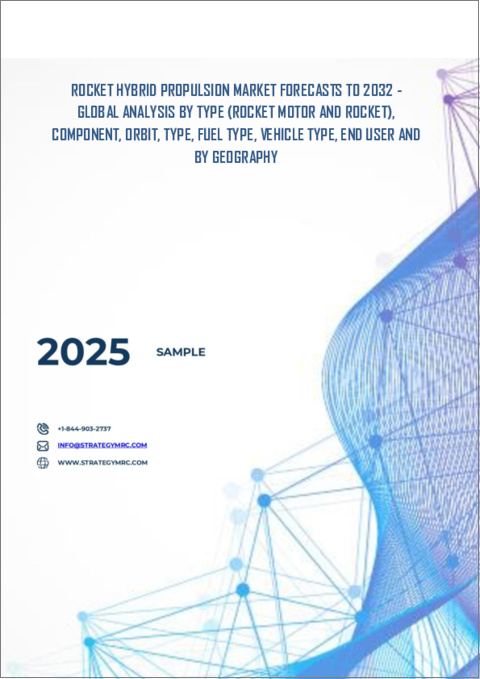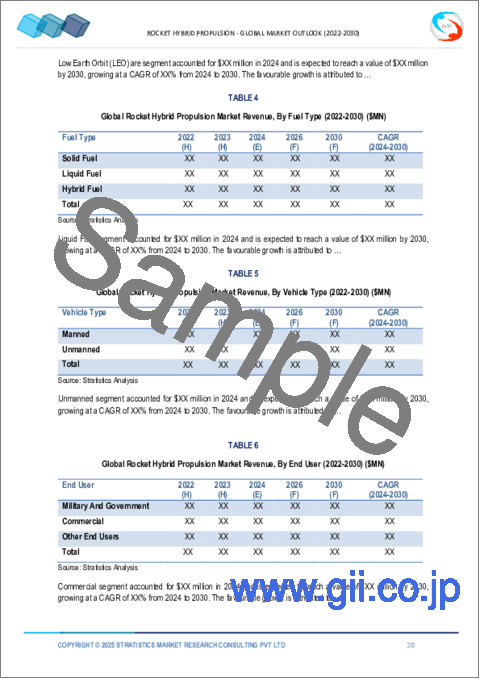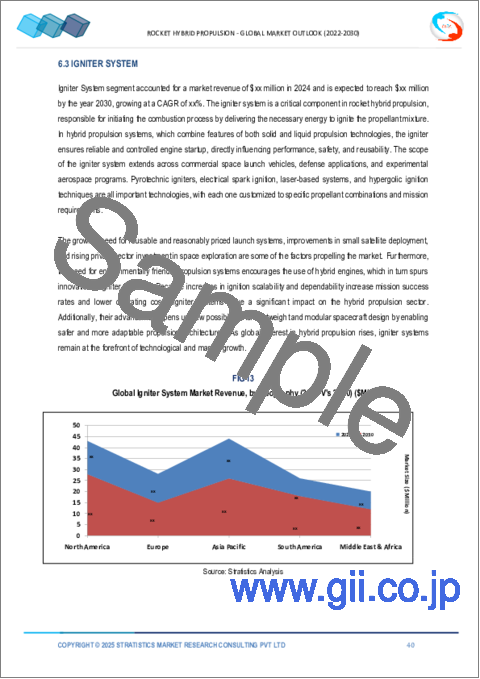|
|
市場調査レポート
商品コード
1734836
ロケットハイブリッド推進市場の2032年までの予測:タイプ別、コンポーネント別、軌道別、タイプ別、燃料タイプ別、車両タイプ別、エンドユーザー別、地域別の世界分析Rocket Hybrid Propulsion Market Forecasts to 2032 - Global Analysis By Type (Rocket Motor and Rocket), Component, Orbit, Type, Fuel Type, Vehicle Type, End User and By Geography |
||||||
カスタマイズ可能
|
|||||||
| ロケットハイブリッド推進市場の2032年までの予測:タイプ別、コンポーネント別、軌道別、タイプ別、燃料タイプ別、車両タイプ別、エンドユーザー別、地域別の世界分析 |
|
出版日: 2025年05月03日
発行: Stratistics Market Research Consulting
ページ情報: 英文 200+ Pages
納期: 2~3営業日
|
全表示
- 概要
- 図表
- 目次
Stratistics MRCによると、世界のロケットハイブリッド推進市場は2025年に74億米ドルを占め、予測期間中にCAGR 9%で成長し、2032年には137億米ドルに達する見込みです。
ロケットハイブリッド推進は、固体燃料と液体または気体の酸化剤を組み合わせた宇宙船推進システムであり、簡便性、制御性、安全性を提供します。固体ロケットや液体ロケットとは異なり、ハイブリッドはスロットル操作やシャットダウンが可能で、実験用や小型衛星の打ち上げに最適です。また、従来のシステムよりも揮発性が低いため、爆発のリスクも低減できます。ハイブリッド推進は、そのコスト効率と運用の柔軟性から、民間宇宙飛行や防衛用途で支持を集めています。
Space Foundationによると、世界の打上げ活動は3年連続で記録的なレベルに達し、2023年には223回の打上げが試みられ、212回の打上げが成功しました。
衛星打ち上げの増加
通信や地球観測を目的とした衛星打ち上げの頻度が増加していることが、ハイブリッド推進システムの需要を促進しています。ハイブリッド推進は、従来のシステムに代わるコスト効率と安全性を提供します。政府や民間企業による宇宙探査への投資の増加が市場成長を後押し。地球低軌道における小型衛星の需要が採用を後押し。ハイブリッド・ロケット・モーターの技術的進歩が性能を向上。持続可能な宇宙ミッションへの注目が市場の可能性を高める。
高い開発コスト
ハイブリッド推進システムの開発には、研究と試験に多額の投資が必要です。高コストが小規模航空宇宙企業の市場参入を阻みます。複雑な製造プロセスにより製造費用が増大します。ニッチな用途では規模の経済が限られるため、手頃な価格が制限されます。特殊な材料が必要なため、経済的負担が大きくなります。開発期間が長いため、投資回収が遅れます。このコスト障壁が市場の拡張性と成長を制限します。
宇宙旅行開発
新興の宇宙旅行産業は、信頼性が高く費用対効果の高いハイブリッド推進システムの需要を生み出しています。ハイブリッド・ロケットは、より安全で再利用可能なサブオービタル飛行の選択肢を提供します。航空宇宙企業と旅行会社の提携が技術革新を促進します。宇宙旅行に対する消費者の関心の高まりが市場機会を押し上げます。商業宇宙飛行に対する規制支援が投資を促進。持続可能な推進システムへの動向が市場の魅力を高める。これらの開発がハイブリッド推進市場の可能性を拡大させています。
代替推進システムとの競合
液体ロケットや固体ロケットなどの代替推進システムは、性能とコストにおいてハイブリッドシステムと競合します。液体推進はより高い効率を提供し、大規模ミッションを惹きつける。従来のシステムには確立されたサプライチェーンがあるため、ハイブリッドの採用には限界があります。電気推進の課題が市場シェアに課題します。ハイブリッドの利点に関する認識不足が成長を妨げます。再使用可能なロケットへのシフトがハイブリッドへの依存度を低下させる。この競合がロケット・ハイブリッド推進市場の拡大を脅かします。
COVID-19の影響:
COVID-19の大流行により衛星打ち上げが遅れ、ハイブリッド推進システムの需要が減少しました。サプライチェーンの混乱はロケット部品の生産に影響を与えました。しかし、宇宙産業の回復はハイブリッド技術への投資を後押ししました。労働力不足とロジスティクスの課題が製造工程を妨げました。パンデミックは、費用対効果の高い推進ソリューションの必要性を浮き彫りにしました。危機後の商業宇宙飛行への関心の高まりが市場の成長を支えました。持続可能な宇宙ミッションへの注目は回復の原動力になると予想されます。
予測期間中、ロケットモーターセグメントが最大になる見込み
ロケットモーター分野は、衛星打ち上げや宇宙ミッションの動力源として重要な役割を果たすことから、予測期間中最大の市場シェアを占めると予想されます。ハイブリッド・ロケット・モーターは安全性と性能のバランスを提供し、採用を促進します。モーター設計の進歩は推力効率と信頼性を高める。小型衛星配備の増加がこの分野の成長を支えています。ハイブリッドモーターの規制認可が市場の信頼を確保。ミッションの種類を問わないモーターの汎用性が市場シェアを強化。費用対効果の高い推進ソリューションに対する需要の高まりがこの分野を強化します。
イグナイタシステム分野は予測期間中に最も高いCAGRが見込まれます。
予測期間中、イグナイタシステム分野は、信頼性が高く再利用可能なイグナイタ技術の革新に牽引され、最も高い成長率を記録すると予測されます。先進的な点火器は、ハイブリッド・ロケット・モーターの安全性と効率を向上させる。頻繁な衛星打ち上げの増加は、堅牢なイグナイター・システムへの需要を煽る。航空宇宙企業との提携が技術進歩を促進。より安全な推進システムに対する規制当局の支援が採用を後押しします。再使用可能なロケットへの注目がセグメントの拡大を促進。宇宙ミッションにおける正確な点火の必要性がこのセグメントの成長を促進します。
最もシェアが高い地域:
予測期間中、アジア太平洋地域は、中国やインドのような国々における強固な宇宙開発計画により、最大の市場シェアを占めると予想されます。衛星打ち上げへの高額の投資がハイブリッド推進の需要を牽引。宇宙探査に対する政府の支援は市場の成長を強化します。主要航空宇宙メーカーの存在が地域の優位性を高める。宇宙ミッションへの民間セクターの関与の高まりが拡大を促進。費用対効果の高い技術への注目が採用を後押し。
CAGRが最も高い地域:
予測期間中、北米地域は商業宇宙飛行と衛星技術への旺盛な投資により、最も高いCAGRを示すと予測されます。同地域の先進的な航空宇宙エコシステムは、ハイブリッド推進における技術革新を促進します。持続可能な宇宙ミッションに対する規制上の支援が採用を後押しします。主要宇宙企業の存在が市場成長を促進。宇宙旅行への関心の高まりが拡大を後押し。民間企業とのパートナーシップが技術進歩を促進。
無料のカスタマイズサービス:
本レポートをご購読のお客様には、以下の無料カスタマイズオプションのいずれかをご利用いただけます:
- 企業プロファイル
- 追加市場プレーヤーの包括的プロファイリング(3社まで)
- 主要企業のSWOT分析(3社まで)
- 地域セグメンテーション
- 顧客の関心に応じた主要国の市場推計・予測・CAGR(注:フィージビリティチェックによる)
- 競合ベンチマーキング
- 製品ポートフォリオ、地理的プレゼンス、戦略的提携に基づく主要企業のベンチマーキング
目次
第1章 エグゼクティブサマリー
第2章 序文
- 概要
- ステークホルダー
- 調査範囲
- 調査手法
- データマイニング
- データ分析
- データ検証
- 調査アプローチ
- 調査資料
- 1次調査資料
- 2次調査情報源
- 前提条件
第3章 市場動向分析
- 促進要因
- 抑制要因
- 機会
- 脅威
- エンドユーザー分析
- 新興市場
- COVID-19の影響
第4章 ポーターのファイブフォース分析
- 供給企業の交渉力
- 買い手の交渉力
- 代替品の脅威
- 新規参入業者の脅威
- 競争企業間の敵対関係
第5章 世界のロケットハイブリッド推進市場:タイプ別
- ロケットモーター
- ロケットエンジン
第6章 世界のロケットハイブリッド推進市場:コンポーネント別
- 燃焼室
- イグナイターシステム
- ノズル/ポンプ
- 推進剤
- その他のコンポーネント
第7章 世界のロケットハイブリッド推進市場:軌道別
- 低軌道(LEO)
- 中軌道(MEO)
- 静止軌道(GEO)
- 静止軌道超え(BGEO)
第8章 世界のロケットハイブリッド推進市場:燃料タイプ別
- 固形燃料
- 液体燃料
- ハイブリッド燃料
第9章 世界のロケットハイブリッド推進市場:車両タイプ別
- 有人
- 無人
第10章 世界のロケットハイブリッド推進市場:エンドユーザー別
- 軍と政府
- 商用
- その他のエンドユーザー
第11章 世界のロケットハイブリッド推進市場:地域別
- 北米
- 米国
- カナダ
- メキシコ
- 欧州
- ドイツ
- 英国
- イタリア
- フランス
- スペイン
- その他欧州
- アジア太平洋
- 日本
- 中国
- インド
- オーストラリア
- ニュージーランド
- 韓国
- その他アジア太平洋地域
- 南米
- アルゼンチン
- ブラジル
- チリ
- その他南米
- 中東・アフリカ
- サウジアラビア
- アラブ首長国連邦
- カタール
- 南アフリカ
- その他中東とアフリカ
第12章 主な発展
- 契約、パートナーシップ、コラボレーション、ジョイントベンチャー
- 買収と合併
- 新製品発売
- 事業拡大
- その他の主要戦略
第13章 企業プロファイリング
- Firehawk Aerospace Inc.
- Novart Space Technologies
- Sierra Space Corporation
- Virgin Galactic
- Pulsar Fusion
- HyPrSpace
- Raytheon Missiles & Defense
- HyImpulse
- Gilmour Space Technologies
- China Aerospace Science and Technology Corporation
- Environmental Aeroscience Corporation
- Nammo AS
- ISRO
- Reaction Dynamics
- INNOSPC
List of Tables
- Table 1 Global Rocket Hybrid Propulsion Market Outlook, By Region (2024-2032) ($MN)
- Table 2 Global Rocket Hybrid Propulsion Market Outlook, By Type (2024-2032) ($MN)
- Table 3 Global Rocket Hybrid Propulsion Market Outlook, By Rocket Motor (2024-2032) ($MN)
- Table 4 Global Rocket Hybrid Propulsion Market Outlook, By Rocket Engine (2024-2032) ($MN)
- Table 5 Global Rocket Hybrid Propulsion Market Outlook, By Component (2024-2032) ($MN)
- Table 6 Global Rocket Hybrid Propulsion Market Outlook, By Combustion Chamber (2024-2032) ($MN)
- Table 7 Global Rocket Hybrid Propulsion Market Outlook, By Igniter System (2024-2032) ($MN)
- Table 8 Global Rocket Hybrid Propulsion Market Outlook, By Nozzle/Pump (2024-2032) ($MN)
- Table 9 Global Rocket Hybrid Propulsion Market Outlook, By Propellant (2024-2032) ($MN)
- Table 10 Global Rocket Hybrid Propulsion Market Outlook, By Other Components (2024-2032) ($MN)
- Table 11 Global Rocket Hybrid Propulsion Market Outlook, By Orbit (2024-2032) ($MN)
- Table 12 Global Rocket Hybrid Propulsion Market Outlook, By Low Earth Orbit (LEO) (2024-2032) ($MN)
- Table 13 Global Rocket Hybrid Propulsion Market Outlook, By Medium Earth Orbit (MEO) (2024-2032) ($MN)
- Table 14 Global Rocket Hybrid Propulsion Market Outlook, By Geostationary Earth Orbit (GEO) (2024-2032) ($MN)
- Table 15 Global Rocket Hybrid Propulsion Market Outlook, By Beyond Geosynchronous Orbit (BGEO) (2024-2032) ($MN)
- Table 16 Global Rocket Hybrid Propulsion Market Outlook, By Fuel Type (2024-2032) ($MN)
- Table 17 Global Rocket Hybrid Propulsion Market Outlook, By Solid Fuel (2024-2032) ($MN)
- Table 18 Global Rocket Hybrid Propulsion Market Outlook, By Liquid Fuel (2024-2032) ($MN)
- Table 19 Global Rocket Hybrid Propulsion Market Outlook, By Hybrid Fuel (2024-2032) ($MN)
- Table 20 Global Rocket Hybrid Propulsion Market Outlook, By Vehicle Type (2024-2032) ($MN)
- Table 21 Global Rocket Hybrid Propulsion Market Outlook, By Manned (2024-2032) ($MN)
- Table 22 Global Rocket Hybrid Propulsion Market Outlook, By Unmanned (2024-2032) ($MN)
- Table 23 Global Rocket Hybrid Propulsion Market Outlook, By End User (2024-2032) ($MN)
- Table 24 Global Rocket Hybrid Propulsion Market Outlook, By Military And Government (2024-2032) ($MN)
- Table 25 Global Rocket Hybrid Propulsion Market Outlook, By Commercial (2024-2032) ($MN)
- Table 26 Global Rocket Hybrid Propulsion Market Outlook, By Other End Users (2024-2032) ($MN)
Note: Tables for North America, Europe, APAC, South America, and Middle East & Africa Regions are also represented in the same manner as above.
According to Stratistics MRC, the Global Rocket Hybrid Propulsion Market is accounted for $7.4 billion in 2025 and is expected to reach $13.7 billion by 2032 growing at a CAGR of 9% during the forecast period. Rocket Hybrid Propulsion is a spacecraft propulsion system combining solid fuel with a liquid or gaseous oxidizer, offering simplicity, controllability, and safety. Unlike solid or liquid rockets, hybrids provide throttleability and shutdown capabilities, making them ideal for experimental and small satellite launches. They are less volatile than conventional systems, reducing explosion risks. Hybrid propulsion is gaining traction in commercial spaceflight and defense applications due to its cost-efficiency and operational flexibility.
According to Space Foundation, the global launch activity reached record levels for the third consecutive year, with 223 launch attempts and 212 successful launches in 2023.
Market Dynamics:
Driver:
Increased satellite launches
The growing frequency of satellite launches for communication and earth observation is driving demand for hybrid propulsion systems. Hybrid propulsion offers cost-effective and safer alternatives to traditional systems. Rising investments in space exploration by governments and private firms fuel market growth. The demand for small satellites in low-earth orbit supports adoption. Technological advancements in hybrid rocket motors enhance performance. The focus on sustainable space missions boosts market potential.
Restraint:
High development costs
The development of hybrid propulsion systems requires significant investment in research and testing. High costs deter small-scale aerospace companies from entering the market. Complex manufacturing processes increase production expenses. Limited economies of scale in niche applications restrict affordability. The need for specialized materials adds financial strain. Long development timelines delay returns on investment. This cost barrier limits market scalability and growth.
Opportunity:
Space tourism developments
The emerging space tourism industry is creating demand for reliable and cost-effective hybrid propulsion systems. Hybrid rockets offer safer and reusable options for suborbital flights. Partnerships between aerospace firms and tourism companies drive innovation. Growing consumer interest in space travel boosts market opportunities. Regulatory support for commercial spaceflight encourages investment. The trend toward sustainable propulsion systems enhances market appeal. These developments are expanding the hybrid propulsion market's potential.
Threat:
Competition from alternative propulsion systems
Alternative propulsion systems, such as liquid and solid rockets, compete with hybrid systems in performance and cost. Liquid propulsion offers higher efficiency, attracting large-scale missions. Established supply chains for traditional systems limit hybrid adoption. Advances in electric propulsion challenge market share. Lack of awareness about hybrid benefits hinders growth. The shift toward reusable rockets reduces reliance on hybrids. This competition threatens the rocket hybrid propulsion market's expansion.
Covid-19 Impact:
The COVID-19 pandemic delayed satellite launches, reducing demand for hybrid propulsion systems. Supply chain disruptions impacted the production of rocket components. However, the recovery of the space industry boosted investments in hybrid technologies. Labor shortages and logistics challenges hindered manufacturing processes. The pandemic highlighted the need for cost-effective propulsion solutions. Rising interest in commercial spaceflight post-crisis supported market growth. The focus on sustainable space missions is expected to drive recovery.
The rocket motor segment is expected to be the largest during the forecast period
The rocket motor segment is expected to account for the largest market share during the forecast period propelled by its critical role in powering satellite launches and space missions. Hybrid rocket motors offer a balance of safety and performance, driving adoption. Advances in motor design enhance thrust efficiency and reliability. The rise in small satellite deployments supports segment growth. Regulatory approvals for hybrid motors ensure market trust. The versatility of motors across mission types strengthens market share. Growing demand for cost-effective propulsion solutions bolsters this segment.
The igniter system segment is expected to have the highest CAGR during the forecast period
Over the forecast period, the igniter system segment is predicted to witness the highest growth rate driven by innovations in reliable and reusable ignition technologies. Advanced igniters improve the safety and efficiency of hybrid rocket motors. The rise in frequent satellite launches fuels demand for robust igniter systems. Partnerships with aerospace firms drive technological advancements. Regulatory support for safer propulsion systems boosts adoption. The focus on reusable rockets enhances segment expansion. The need for precise ignition in space missions propels this segment's growth.
Region with largest share:
During the forecast period, the Asia Pacific region is expected to hold the largest market share owing to its robust space programs in countries like China and India. High investments in satellite launches drive demand for hybrid propulsion. Government support for space exploration strengthens market growth. The presence of key aerospace manufacturers enhances regional dominance. Rising private sector involvement in space missions fuels expansion. The focus on cost-effective technologies supports adoption.
Region with highest CAGR:
Over the forecast period, the North America region is anticipated to exhibit the highest CAGR fueled by strong investments in commercial spaceflight and satellite technologies. The region's advanced aerospace ecosystem drives innovation in hybrid propulsion. Regulatory support for sustainable space missions boosts adoption. The presence of leading space companies fosters market growth. Growing interest in space tourism supports expansion. Partnerships with private firms drive technological advancements.
Key players in the market
Some of the key players in Rocket Hybrid Propulsion Market include Firehawk Aerospace Inc., Novarris Space Technologies, Sierra Space Corporation, Virgin Galactic, Pulsar Fusion, HyPrSpace, Raytheon Missiles & Defense, HyImpulse, Gilmour Space Technologies, China Aerospace Science and Technology Corporation, Environmental Aeroscience Corporation, Nammo AS, ISRO, Reaction Dynamics, and INNOSPACE.
Key Developments:
In March 2025, Virgin Orbit partnered with Aerojet Rocketdyne to develop LOX-paraffin hybrid engines for its next-gen LauncherOne, targeting reusable, low-cost orbital deployments by 2026.
In February 2025, PLD Space unveiled its methanol-based hybrid propulsion system for the Miura 5 rocket, featuring throttleable thrust for precise payload delivery to LEO..
Types Covered:
- Rocket Motor
- Rocket Engine
Components Covered:
- Combustion Chamber
- Igniter System
- Nozzle/Pump
- Propellant
- Other Components
Orbits Covered:
- Low Earth Orbit (LEO)
- Medium Earth Orbit (MEO)
- Geostationary Earth Orbit (GEO)
- Beyond Geosynchronous Orbit (BGEO)
Fuel Types Covered:
- Solid Fuel
- Liquid Fuel
- Hybrid Fuel
- Other Fuel Types
Vehicle Types Covered:
- Manned
- Unmanned
End Users Covered:
- Military And Government
- Commercial
- Other End Users
Regions Covered:
- North America
- US
- Canada
- Mexico
- Europe
- Germany
- UK
- Italy
- France
- Spain
- Rest of Europe
- Asia Pacific
- Japan
- China
- India
- Australia
- New Zealand
- South Korea
- Rest of Asia Pacific
- South America
- Argentina
- Brazil
- Chile
- Rest of South America
- Middle East & Africa
- Saudi Arabia
- UAE
- Qatar
- South Africa
- Rest of Middle East & Africa
What our report offers:
- Market share assessments for the regional and country-level segments
- Strategic recommendations for the new entrants
- Covers Market data for the years 2024, 2025, 2026, 2028, and 2032
- Market Trends (Drivers, Constraints, Opportunities, Threats, Challenges, Investment Opportunities, and recommendations)
- Strategic recommendations in key business segments based on the market estimations
- Competitive landscaping mapping the key common trends
- Company profiling with detailed strategies, financials, and recent developments
- Supply chain trends mapping the latest technological advancements
Free Customization Offerings:
All the customers of this report will be entitled to receive one of the following free customization options:
- Company Profiling
- Comprehensive profiling of additional market players (up to 3)
- SWOT Analysis of key players (up to 3)
- Regional Segmentation
- Market estimations, Forecasts and CAGR of any prominent country as per the client's interest (Note: Depends on feasibility check)
- Competitive Benchmarking
- Benchmarking of key players based on product portfolio, geographical presence, and strategic alliances
Table of Contents
1 Executive Summary
2 Preface
- 2.1 Abstract
- 2.2 Stake Holders
- 2.3 Research Scope
- 2.4 Research Methodology
- 2.4.1 Data Mining
- 2.4.2 Data Analysis
- 2.4.3 Data Validation
- 2.4.4 Research Approach
- 2.5 Research Sources
- 2.5.1 Primary Research Sources
- 2.5.2 Secondary Research Sources
- 2.5.3 Assumptions
3 Market Trend Analysis
- 3.1 Introduction
- 3.2 Drivers
- 3.3 Restraints
- 3.4 Opportunities
- 3.5 Threats
- 3.6 End User Analysis
- 3.7 Emerging Markets
- 3.8 Impact of Covid-19
4 Porters Five Force Analysis
- 4.1 Bargaining power of suppliers
- 4.2 Bargaining power of buyers
- 4.3 Threat of substitutes
- 4.4 Threat of new entrants
- 4.5 Competitive rivalry
5 Global Rocket Hybrid Propulsion Market, By Type
- 5.1 Introduction
- 5.2 Rocket Motor
- 5.3 Rocket Engine
6 Global Rocket Hybrid Propulsion Market, By Component
- 6.1 Introduction
- 6.2 Combustion Chamber
- 6.3 Igniter System
- 6.4 Nozzle/Pump
- 6.5 Propellant
- 6.6 Other Components
7 Global Rocket Hybrid Propulsion Market, By Orbit
- 7.1 Introduction
- 7.2 Low Earth Orbit (LEO)
- 7.3 Medium Earth Orbit (MEO)
- 7.4 Geostationary Earth Orbit (GEO)
- 7.5 Beyond Geosynchronous Orbit (BGEO)
8 Global Rocket Hybrid Propulsion Market, By Fuel Type
- 8.1 Introduction
- 8.2 Solid Fuel
- 8.3 Liquid Fuel
- 8.4 Hybrid Fuel
9 Global Rocket Hybrid Propulsion Market, By Vehicle Type
- 9.1 Introduction
- 9.2 Manned
- 9.3 Unmanned
10 Global Rocket Hybrid Propulsion Market, By End User
- 10.1 Introduction
- 10.2 Military And Government
- 10.3 Commercial
- 10.4 Other End Users
11 Global Rocket Hybrid Propulsion Market, By Geography
- 11.1 Introduction
- 11.2 North America
- 11.2.1 US
- 11.2.2 Canada
- 11.2.3 Mexico
- 11.3 Europe
- 11.3.1 Germany
- 11.3.2 UK
- 11.3.3 Italy
- 11.3.4 France
- 11.3.5 Spain
- 11.3.6 Rest of Europe
- 11.4 Asia Pacific
- 11.4.1 Japan
- 11.4.2 China
- 11.4.3 India
- 11.4.4 Australia
- 11.4.5 New Zealand
- 11.4.6 South Korea
- 11.4.7 Rest of Asia Pacific
- 11.5 South America
- 11.5.1 Argentina
- 11.5.2 Brazil
- 11.5.3 Chile
- 11.5.4 Rest of South America
- 11.6 Middle East & Africa
- 11.6.1 Saudi Arabia
- 11.6.2 UAE
- 11.6.3 Qatar
- 11.6.4 South Africa
- 11.6.5 Rest of Middle East & Africa
12 Key Developments
- 12.1 Agreements, Partnerships, Collaborations and Joint Ventures
- 12.2 Acquisitions & Mergers
- 12.3 New Product Launch
- 12.4 Expansions
- 12.5 Other Key Strategies
13 Company Profiling
- 13.1 Firehawk Aerospace Inc.
- 13.2 Novart Space Technologies
- 13.3 Sierra Space Corporation
- 13.4 Virgin Galactic
- 13.5 Pulsar Fusion
- 13.6 HyPrSpace
- 13.7 Raytheon Missiles & Defense
- 13.8 HyImpulse
- 13.9 Gilmour Space Technologies
- 13.10 China Aerospace Science and Technology Corporation
- 13.11 Environmental Aeroscience Corporation
- 13.12 Nammo AS
- 13.13 ISRO
- 13.14 Reaction Dynamics
- 13.15 INNOSPC





